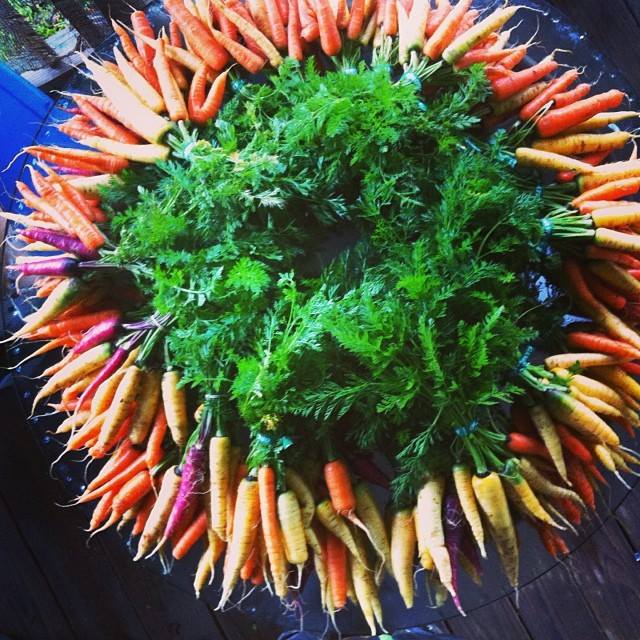
by Molly Jameson | Jul 12, 2017

The modern carrot is available in many sizes, colors, and flavor profiles thanks to thousands of years of plant breeding. Photo by Kelly Thomas.
Fruits and vegetables have undergone various forms of domestication for thousands of years. Throughout this time, selective breeding of wild forages has allowed humans to develop crops with many desirable traits, such as increased size, higher sugar content, more nutrition, and brighter colors.
If you ate a carrot 5,000 years ago, you would be in for a surprise. First, it would not be orange. Instead, it would be white or purple, and would taste very bitter and be very small. We think wild carrots were first cultivated around 1,100 years ago, but that it took another 600 years to develop carrots that are not only available in white and purple, but also yellow, orange, and even red.
Sweet corn 9,000 years ago was a thousand times smaller, and barely edible, tasting more like a raw dried potato than corn, with only a few hard kernels per ear.
When you trace back the history of fruits and vegetables, you not only see many changes taking place through human intervention, but also many rituals, beliefs, and superstitions along the way. Take the mighty onion, for example. Did you know that Greek athletes in the Ancient Olympic Games would eat pounds of raw onion, drink the juice of onions, and rub onions all over their bodies before competing?
Roman generals believed garlic gave soldiers courage and strength, so they planted whole fields of it in areas they conquered, believing this transferred bravery to the armies. According to ancient Egyptian records, the Pharaoh gave the Egyptian slaves who built the pyramids garlic daily, along with their meager rations of beer and flat bread, as a means to increase strength and endurance. By today’s standards, it is believed it cost the Pharaoh two million dollars to keep the slaves supplied with garlic.
The Aztecs domesticated tomatoes around 500 BC, but they were not introduced to Italy until the 16th century. Even then, it took Italians another 250 years to embrace the tomato, as this member of the nightshade family was – understandably – feared to be poisonous. Can you imagine your pizzas and spaghetti without marinara?
Cucumbers originated in India, where their domestication started more than 4,000 years ago. They were traded to the Middle East and Europe about 3,000 years ago, and were even mentioned in the Epic of Gilgamesh. In Ancient Rome, Emperor Tiberius, who reigned briefly from 14 to 16 AD, demanded that he be served cucumbers daily. In the winter, his gardeners had to grow cucumbers in mobile wooden frames to protect the plants and expose them to the sun.
So the next time you enjoy the crunch of a bright orange carrot, sink your teeth into a chunk of hot garlic bread, or nurture your prized heirloom tomatoes, reflect back on just what it took our ancestors to get to the fruits and vegetables we relish today.
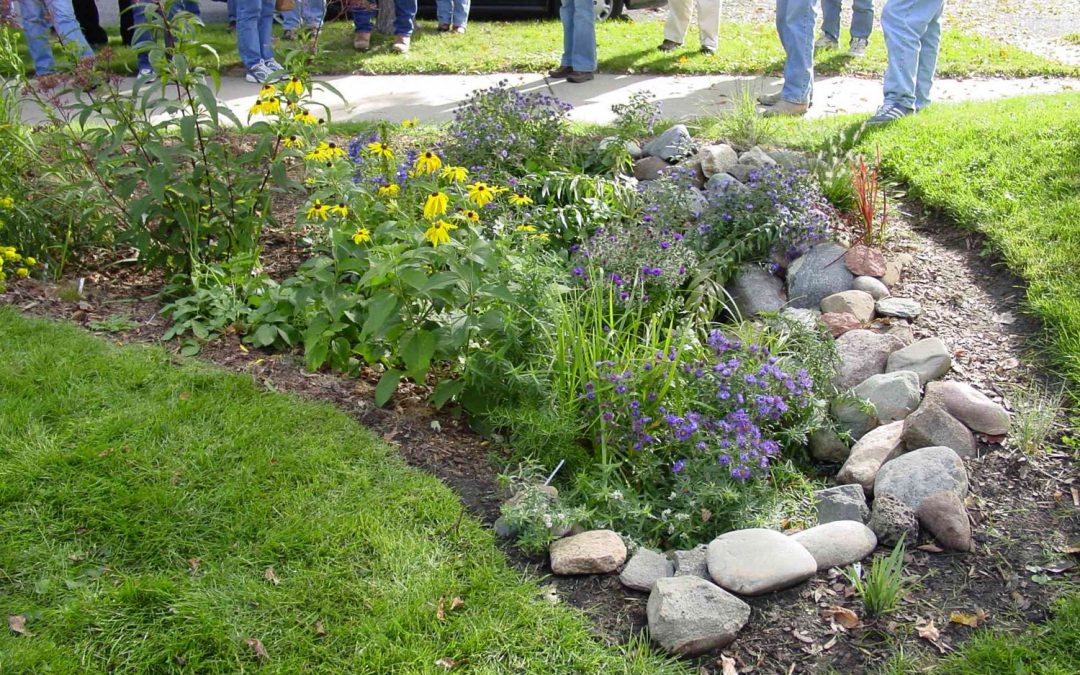
by Carrie Stevenson | Jul 5, 2017
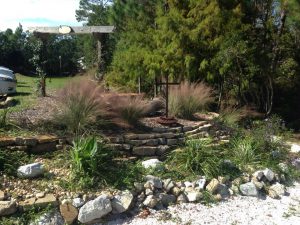
This rain garden used stone for a berm and muhly grass as a decorative and functional plant. Photo credit, Jerry Patee
Tropical Storm Cindy’s early arrival soaked northwest Florida this month, followed by even more heavy rain. Homes in low areas and along the rivers flooded and suffered extensive damage. That being said, we are just entering our summer “rainy season,” so it may be wise to spend extra time thinking about adjusting your landscape to handle our typically heavy annual rainfall.
For example, if you have an area in your yard where water always runs after a storm (even a mild one) and washes out your property, you may want to consider a rain garden for that spot. Rain gardens are designed to temporarily hold rainwater and allow it to soak into the ground. However, they are quite different aesthetically from stormwater ponds, because they are planted with water-tolerant trees, shrubs, groundcovers and flowers to provide an attractive alternative to the eroding gully that once inhabited the area! Rain gardens are not “created wetlands,” but landscaped beds that can handle both wet and drier conditions. Many of the plants best suited for rain gardens are also attractive to wildlife, adding another element of beauty to the landscape.
A perfect spot for a rain garden might be downhill from a rain gutter, an area notorious for excess water and erosion. To build a rain garden, the rainwater leaving a particular part of the property (or rooftop), is directed into a gently sloping, 4”-8” deep depression in the ground, the back and sides of which are supported by a berm of earth. The rain garden serves as a catch basin for the water and is usually shaped like a semi-circle. The width of the rain garden depends on the slope and particular site conditions in each yard. Within the area, native plants are placed into loose, sandy soil and mulched. Care should be taken to prevent the garden from having a very deep end where water pools, rather allowing water to spread evenly throughout the basin.
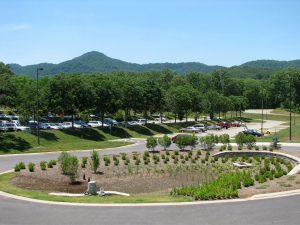
This larger rain garden, or bioretention area, functions as stormwater treatment for a large parking lot in North Carolina. Photo credit: Carrie Stevenson, UF / IFAS Extension
Besides reducing a problematic area of the lawn, a rain garden can play an important role in improving water quality. With increasing populations come more pavement, roads, and rooftops, which do almost nothing to absorb or treat stormwater, contributing to the problem. Vegetation and soil do a much better job at handling stormwater. Excess sediment, which can fill in streams and bays, and chemicals from fertilizers and pesticides are just some of the pollutants treated within a rain garden via the natural growth processes of the plants.
A handful of well-known plants that work great in rain gardens include: Louisiana iris, cinnamon fern, buttonbush, Virginia willow, black-eyed Susan, swamp lily, tulip poplar, oakleaf hydrangea, wax myrtle, Florida azalea, river birch, holly, and Southern magnolia. For a complete list of rain garden plants appropriate for our area, visit the “Rain Garden” section of Tallahassee’s “Think about Personal Pollution” website.
For design specifications on building a rain garden, visit the UF Green Building site or contact your local UF IFAS County Extension office.
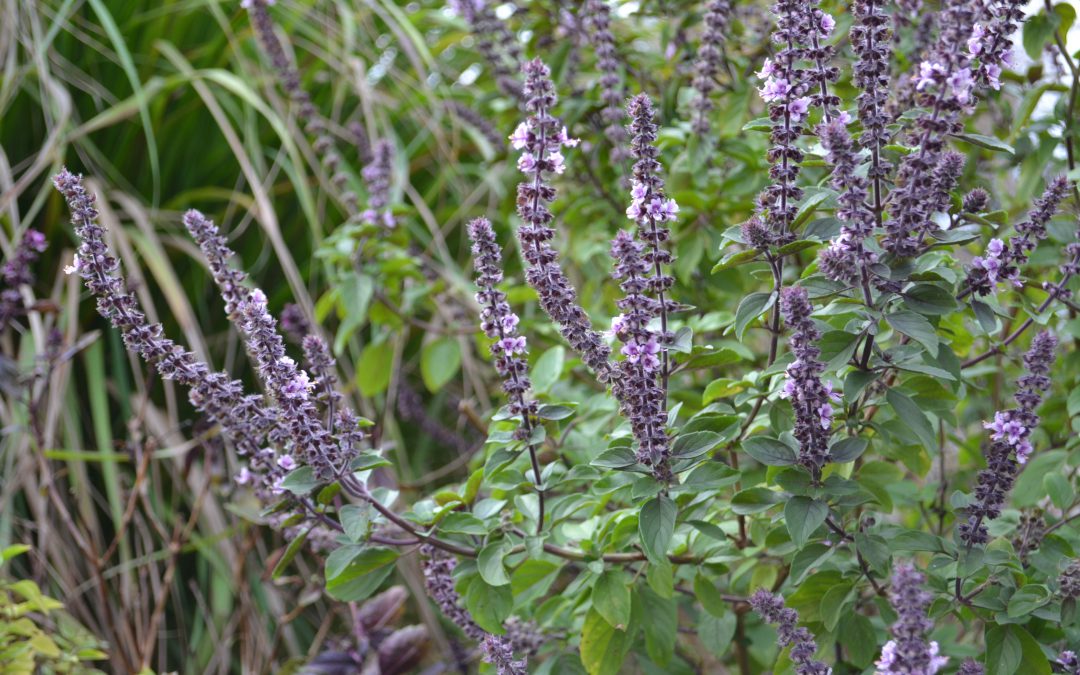
by Beth Bolles | Jul 5, 2017
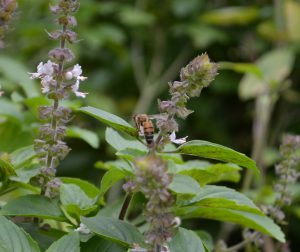
Many bees and beneficial wasps will be attracted to African blue basil. Photo by Beth Bolles, UF IFAS Extension Escambia County
Basil is a favorite plant in the summer herb garden and an absolute must for those who enjoy fresh leaves for a sandwich or delicious homemade pesto. While we grow basils as a food enhancer, an added benefit is that those basil selections that form flowers are very attractive to pollinators. If you would rather not let your favorite basil form flowers, consider adding a specific species that is grown more for its attractiveness to pollinators than its culinary uses.
African blue basil is a hybrid of two basils that has inherited a camphor flavor from one of its parents. Although edible, the flavor may not be appealing to those who are familiar with more traditional basil flavors. Plants produce abundant flowers that are pink with a dark purple base, although flowers are sterile so no seeds will be formed. If you want more African blue basil, you must purchase transplants or start your own from cuttings off the main plants.
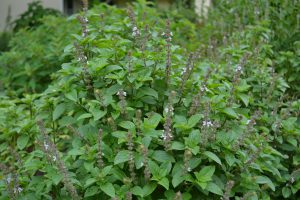
African blue basil enhances gardens and landscapes. Photo by Beth Bolles, UF IFAS Extension Escambia County
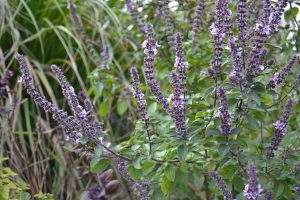
Flowers of African blue basil are also showy in the garden. Photo by Beth Bolles, UF IFAS Extension Escambia County
Like other basils, African blue basil does like soils amended with composts that are well-drained. Plants thrive in full sun and will form rounded mounds that will be much larger than more culinary basils, up to five feet in some gardens. Plants do form woody stems and although frost tender, some plants may return in the spring in more protected areas.
Although some edible gardeners may not want to allow space for a basil that they will not use in the kitchen, the amount of pollinator activity on this selection makes it a benefit to any edible garden for all the frost-free months.
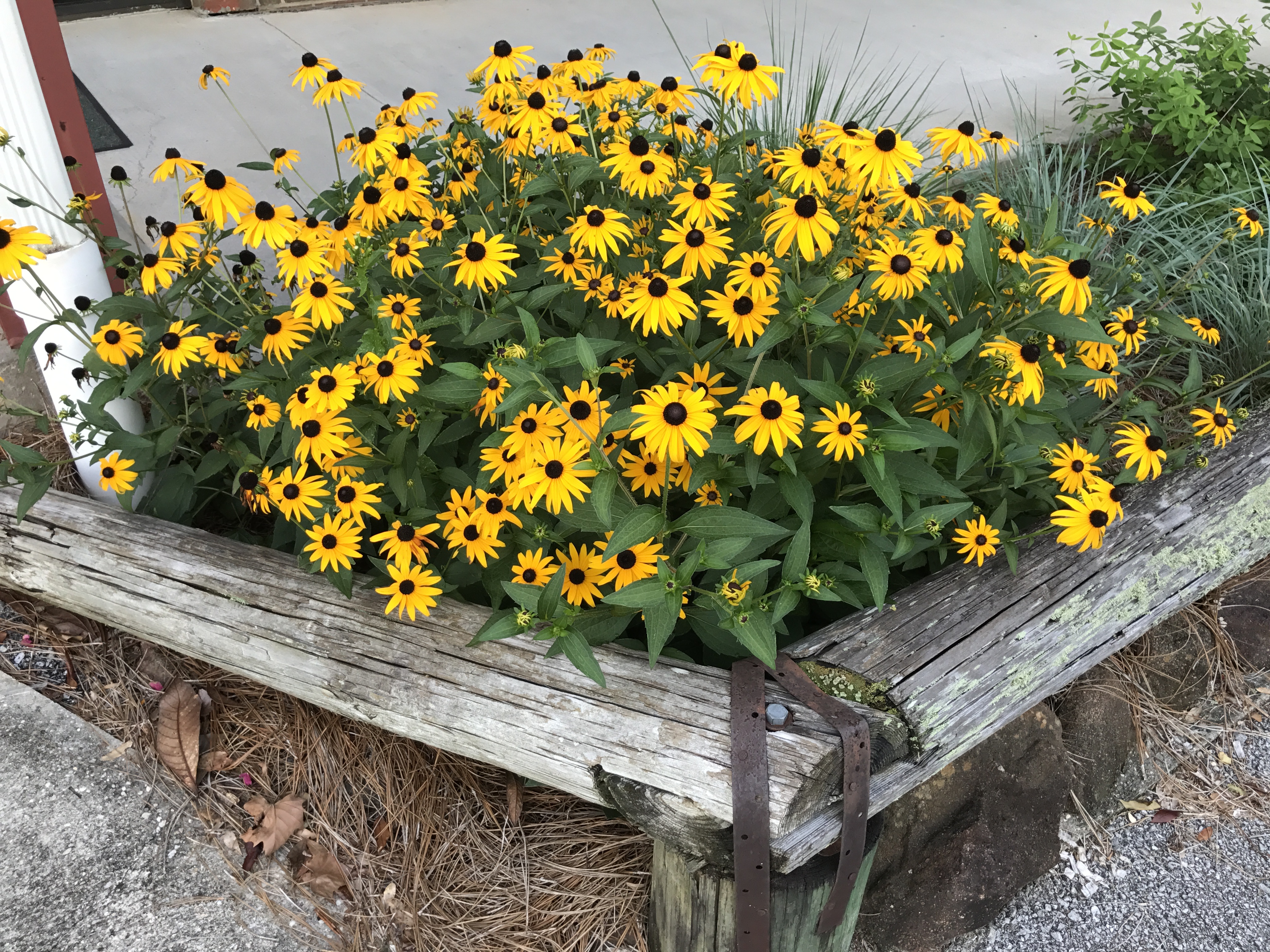
by Daniel J. Leonard | Jul 5, 2017
Let’s be honest with each other and have a moment of transparency, one gardener to another. Even though we are plant people, most of us get a lot less enthusiastic once the mercury explodes over 90 degrees each June. All the things that were fun in the spring (watering our favorite fickle plants, deadheading spent flowers, staking, tying, fertilizing, the list goes on) have ceased to be fun. At this point, like a baby bird pushed out of the nest, the plants in our yards have to either fly or die. Fortunately, if we select the correct, tough-as-nails plants to start with, our gardens do not have to decline when we retreat into the air conditioning! The following are four of my favorite ironclad native perennials that will reward you with color, texture, and overall excellent performance all summer and ask very little in return!
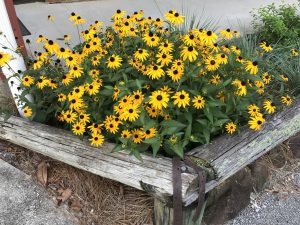
Black-Eyed Susan ‘Goldsturm’ (Rudbeckia fulgida var. sullivanti ‘Goldsturm’)
There is no more reliable plant in the garden than plain old Black-Eyed Susan. This beauty delivers yellow-gold flowers with its namesake black, cone-like centers perpetually from May to frost in the Panhandle and returns like clockwork each spring to do it all over again! While not exactly native, the 1937 selection ‘Goldsturm’ is still easily the most popular Rudbeckia eighty years later, with good reason. ‘Goldsturm’ improves upon the native Rudbeckias in almost every way. It is a more compact plant, forming a spreading mass of flowers about two feet in height, sports larger, showier flowers than the species, and flaunts lustrous dark green foliage. If low-maintenance, raw flower power is what you are after, Black-Eyed Susan ‘Goldsturm’ is right for you!
If the landscape calls for a plant with flowers hotter than the July sun, Scarlet Sage is hard to beat! This tough, prolific perennial boasts fire engine red, tubular-shaped flowers throughout the warm season in Northwest Florida and is one of the very best attractors of a host of pollinators including butterflies and hummingbirds. Growing this native couldn’t be easier, it is not picky about soil type and texture so long as it doesn’t stay waterlogged, it requires little to no supplemental fertilizer or water, and will thrive in full sun or partial shade. A word of warning before planting Scarlet Sage however, be aware that the plant will self-sow prolifically, potentially appearing in unwanted places and becoming a nuisance. Though with a plant this undemanding and pretty, I do not mind one bit if it decides to ramble through the landscape.
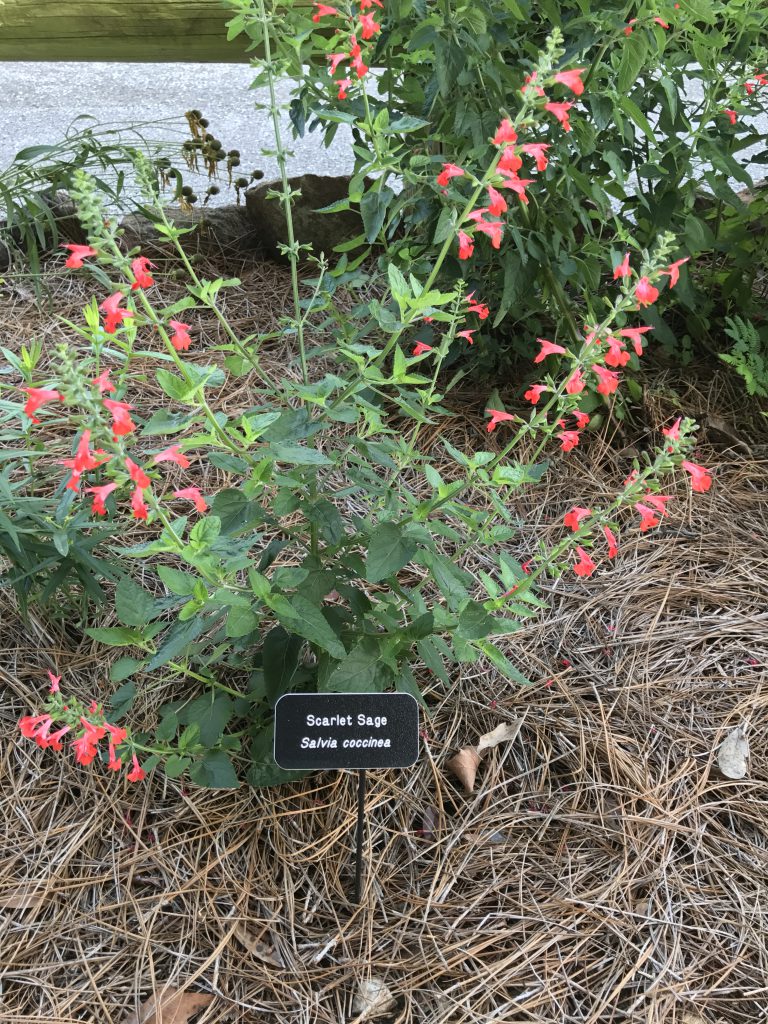
Scarlet Sage (Salvia coccinea)
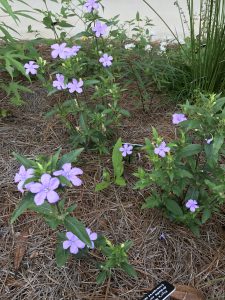
Carolina Petunia (Ruellia caroliniensis) (note: Not to be confused with Mexican Petunia (Ruellia simplex), which, despite its popularity, is an invasive weed and should not be planted)
For those of you that lament hot weather because it means the decline of the showy annual petunias sold by the thousands at big box stores across the South, there is a summer solution for you! Carolina Petunia is a compact (growing to 24” in height), hardy plant whose many outstanding ornamental qualities, including soft purple flowers produced in profusion, make it a great addition to virtually any garden border. It is not picky regarding soil and while flowering is best in full sun, it grows just fine in the dappled shade of pines or other taller perennials and shrubs. Like Scarlet Sage, Carolina Petunia will seed around in the landscape but is easily managed and never wears out its welcome.
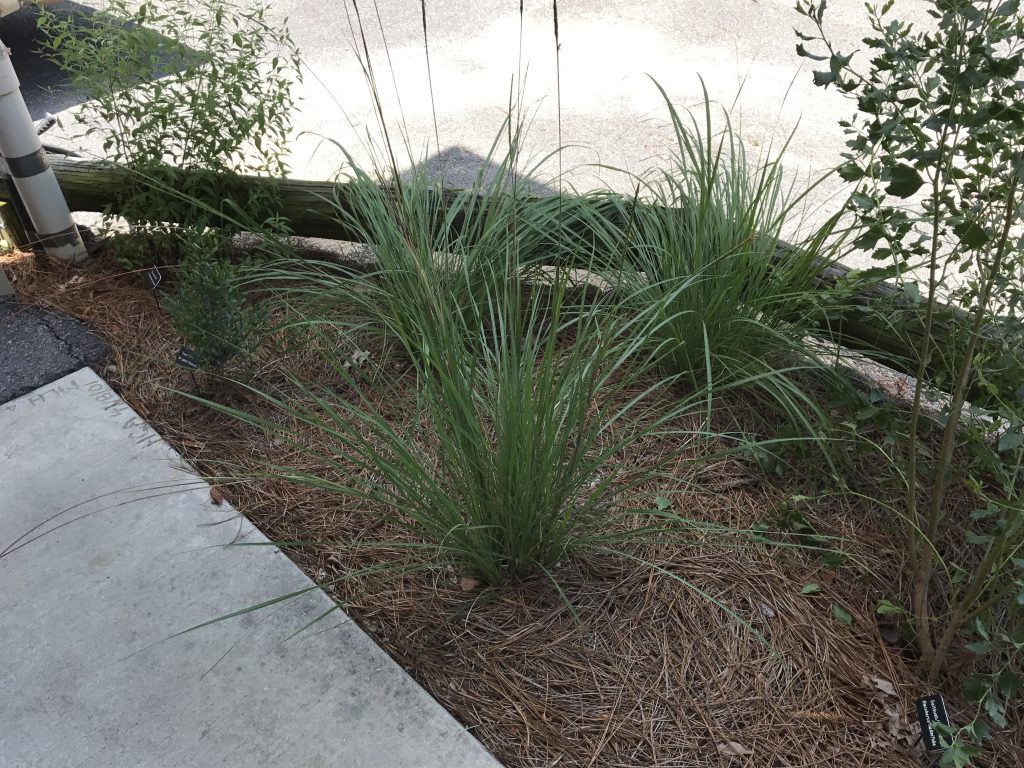
Dwarf Fakahatchee Grass (Tripsacum floridanum)
Ornamental grasses have gained in popularity over the last few years and with good reason! Ornamental grasses tend to be drought tolerant, laugh at the summer sun, and require little maintenance. However, many popular ornamental grass species like Miscanthus, Muhlenbergia, Pennisetum, and others tend to grow too large for most gardens and end up being replaced a few years later. Dwarf Fakahatchee fits this niche perfectly, with its emerald green leaf blades only growing 2-3’ in height and width. It is also more adaptable than most ornamental grass species as it will thrive in sun or partial shade and is tolerant of both wet and dry sites! While it lacks the colorful flower panicles of Muhly Grass or Miscanthus, Dwarf Fakahatchee does possess interesting brown flower stalks and seed heads as well!
All of these awesome low-maintenance, native perennial selections can be purchased at member nurseries of FANN (Florida Association of Native Nurseries) or local independent garden centers. As always, if you have any questions about this or other horticultural topics, contact your local UF/IFAS County Extension Office.














